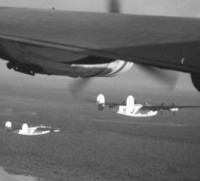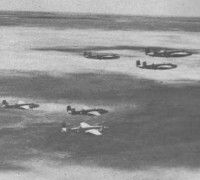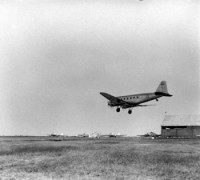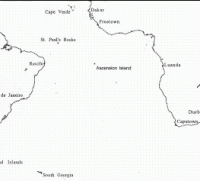SOUTH ATLANTIC FERRY ROUTE TO AFRICA - FERRY FLIGHTS
2)NORTH AFRICA MISSION
A North Africa military mission under Brig. Gen. Russell H. Maxwell had been established at Cairo on 13 September 1941, with responsibilities similar to those of the special observers in London; and, as plans were laid for an increasing flow of American air material to the Middle East, attention was directed to ways and means by which assistance could be rendered in meeting special problems of maintenance and supply for U.S.-built aircraft.
A military air transport service over the South Atlantic, linking Washington with Cairo, was opened on 14 November 1941. As early as July of that year, when the North Atlantic shuttle service started, the Ferrying Command had begun looking ahead for an alternate route to which operations could be shifted with the approach of winter.
At that time, no serious consideration was given to opening a service to Cairo. The immediate need was to find a more southerly, all-weather route into the British Isles in order to maintain the air connection with London and, even more important, to enable the British to continue during the winter the uninterrupted movement of bombers from North America to the home base. A glance at the map will show that the shortest and best possible alternate routes crossed the middle Atlantic by way of Bermuda and the Azores or direct from Newfoundland to the Azores, and thence northeast to the United Kingdom.
Use of the Azores depended on the consent of Portugal, and negotiations were opened with that country for the establishment of an airdrome on one of the islands in the group, to be manned by a security force of American air and ground troops. No definite answer had been received from the Portuguese government when the North Atlantic shuttle service was suspended on 18 October 1941. Upon the request of the Ferrying Command, the State Department again pressed for an answer, but Portugal was unwilling to jeopardize its neutrality. Blocked for the time being in the effort to establish a transport service across the middle Atlantic to Britain, the Air Corps turned its attention in October and November 1941 to the opening of a service to Cairo over the South Atlantic route.
Two survey flights were made over the route in Ferrying Command B-24's in September and early October. The first of these, which served also to carry Maj. Gen. George H. Brett, Chief of the Air Corps, on a special mission to the Middle East, left Boilling Field on 31 August for Cairo and proceeded as far as Basra at the head of the Persian Gulf before returning to Washington on 7 October.
Lt. Col. Caleb V. Haynes served as pilot and Maj. Curtis E. LeMay as co-pilot on this pioneer 26,000-miles trip, the first flight over the whole of the South Atlantic route from the United States to the Middle East and return. Shortly thereafter, Lieutenant Reichers traversed approximately the same route from east to west on his flight home from Moscow.
The decision to open a regular transport service came early in November following a request for the transportation of personnel and equipment to Cairo to organize the air section of the U.S. North African Military Mission. Formal orders to open a regular service were given to the Ferrying Command, and on 14 November the first B-24 left Bolling Field. Lt. Edson E. Kester was at the controls, with Capt. Lawrence M. Thomas acting as co-pilot. Brig. Gen. Elmer E. Adler, newly appointed chief of the air section of the mission, headed the passenger list. Four other transports departed Washington for Cairo prior to 7 December, each carrying important military of diplomatic personnel as well as high-priority cargo and mail.
The service continued on a special-mission basis during the critical early months of the war, pending the establishment of a greatly expanded and more regularly scheduled contract carrier operation over the route.
In the course of his mission to the Middle East in September, General Brett reached the conclusion that the long-range B-24 bomber would provide an effective and quick means of attacking the Germans in southern Europe and of taking definite offensive action against the Axis forces in North Africa. Having proceeded from Cairo to London he found the British receptive to a suggestion that twenty B-24's be diverted from a scheduled delivery for service in the United Kingdom to the Middle East.
It was decided that the number of planes should be reduced to sixteen (the initial equipment of one squadron), that provision would have to be made for training the British crews in the Middle East, and that a stock of spare parts and supplies should be sent out from the United States. Tentative agreements reached in London were conveyed on 17 October to General Arnold, who gave his approval.
The task of making the preliminary arrangements and delivering the sixteen Liberators devolved upon the Ferrying Command. Heretofore, Ferrying Command deliveries had been to "the point of ultimate take-off" within the Western Hemisphere.
These were to be the first deliveries beyond the continent by military crews of the Ferrying Command and the first combat aircraft to be sent over the southeastern route to Africa. There was no alternative to the use of military crews. Pan American Air Ferries' pilots were trained for the ferrying of two-engine aircraft, not four-engine. military crews became available by the coincidence that on 18 October the Ferrying Command's B-24 shuttle service over the North Atlantic to Great Britain was suspended, temporarily it was believed at the time, pending winterization of the aircraft and the improvement of weather and communications facilities.
Before ferrying by military crews to Africa could begin, it became necessary to secure an amendment to the Presidential directive of 3 October 1941, under which the Ferrying Command then was operating.
This directive authorized the command to make deliveries only to "any territory subject to the jurisdiction of the United States, to any territory within the Western Hemisphere, the Netherlands East Indies and Australia." Authority to extend the ferrying service was obtained on 29 October. In a letter to the Secretary of War on that date, the President authorized the deliver of aircraft "to any point within the African continent."
On 24 November the President issued a "blank check" directive authorizing extension of deliveries "to such other places and in such manner as may be necessary to carry out the Lend-Lease program," an enlargement of authority which could be made greater by nothing short of war.
More than a month of preparation had been required before the Liberators were ready to start moving, one at a time, from the United States. With Lt. Elbert D. Reynolds, an experienced trans-Atlantic flyer, acting as pilot, the first of the bombers departed Bolling Field for Cairo on 20 November. Unfortunately, on the trip across Africa the navigator lost his way and, after failing to locate El Fasher, Reynolds was forced to make a night landing at El Obeid. The heavy bomber landed on a shoulder of the runway and was wrecked beyond repair, although the crew was saved.
Four other aircraft of the sixteen-Liberator project departed the United States prior to 7 December, and all four were delivered safely in Cairo. But on America's entry into war, the remainder were turned back at Miami or intermediate domestic stations to become part of a yet-more-urgent movement of heavy bombers to the Far East for the relief of the Philippines. Measures taken by the United States in the immediate prewar period for development of the South Atlantic route proved to be more important as preparation for the impending war than for the ferrying and transport work actually accomplished.
Only a handful of planes, ferried and transport, moved over the route prior to Pearl Harbor. But thanks to the work of the Air Corps Ferrying Command and the Pan American organization, and to the courage and resourcefulness of the pioneer crews who flew the route, the United States had made a substantial start toward the development of a vital line of communications when, after 7 December, aircraft and supplies for its own forces joined the increasing flow of lend-lease goods to the Middle East, to India, China, and the Southwest Pacific -- 30 June 1942.
Transcribed by Patrick Clancey - Hyper War Foundation



